|
|
|
Sort Order |
|
|
|
Items / Page
|
|
|
|
|
|
|
| Srl | Item |
| 1 |
ID:
103127
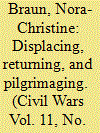

|
|
|
|
|
| Publication |
2009.
|
| Summary/Abstract |
This article analyses the repatriation of a group of internally displaced persons which took place in 2003 in north-western Colombia. Starting with the question of why, in spite of all reservations, the displaced families were taken back to a war zone, the author demonstrates how, on the one hand, the repatriation was part of a power game between the protagonists in the armed conflict and how, on the other, the return of the families was a way of resisting the violent social orders that the paramilitary, the army and the guerrillas had established in the region. The repatriation was the starting point for the creation of a social order based on non-violence. Thus it was the scene of a struggle about social orders or, to put it in another way, about the principles on which Colombian society should be based - a struggle fought out with violent and non-violent means.
|
|
|
|
|
|
|
|
|
|
|
|
|
|
|
|
| 2 |
ID:
110759
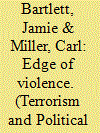

|
|
|
|
|
| Publication |
2012.
|
| Summary/Abstract |
Radicalization is often seen as a first, prerequisite step along the road towards terrorism. Yet to be radical is merely to reject the status quo, and not necessarily in a problematic or violent way. In Part 1-"Radicals"-this article compares the backgrounds, ideologies, behaviours, and attitudes of a sample of "violent radicals" with both radical and "mainstream" non-violent sample groups. By finding both what the violent and non-violent samples share, and also what they do not, the article hopes to achieve a more adept discrimination of violent and non-violent radicalization. In Part 2-"Radicalization"-the article suggests that, in addition to being an intellectual, rational, and religious decision, becoming a terrorist is also an emotional, social, and status-conscious one.
|
|
|
|
|
|
|
|
|
|
|
|
|
|
|
|
| 3 |
ID:
094696
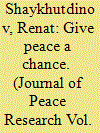

|
|
|
|
|
| Publication |
2010.
|
| Summary/Abstract |
This study examines factors that predict the formation of territorial autonomy arrangements for regionally concentrated ethnic communities. Territorial autonomies are institutional arrangements that allow ethnic groups to express their distinct identities while keeping the borders of host states intact. Although an extensive literature has investigated the capacity of autonomy arrangements to manage interethnic disputes, little research has addressed the precise origins of these institutions. The existing literature considers violent tactics as a primary factor that enables ethnic collectivities to attain territorial autonomy. In this study, the reasoning from the extant literature is juxtaposed with the arguments developed in the research on nonviolent opposition. Nonviolent movements enjoy moral advantage vis-à-vis violent groups. Moreover, peaceful tactics have the advantage of garnering attention for the concerns of ethnic groups without the liability of provoking the animosity or distrust created by violent conflict. Based on the analysis of a dataset representing 168 ethnic groups across 87 states from 1945 to 2000, it is found that the peaceful tactics groups employ when seeking greater self-rule is the single strongest predictor of the formation of autonomy arrangements. In particular, this study concludes that groups that rely on peaceful tactics, such as protests and strikes, and demand territorial autonomy, as opposed to an outright independence, have a greater potential to achieve territorial autonomy in comparison to those groups making extreme demands through the use of violence.
|
|
|
|
|
|
|
|
|
|
|
|
|
|
|
|
| 4 |
ID:
139476
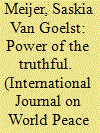

|
|
|
|
|
| Summary/Abstract |
Conflicting global narratives on good or right living, based on conflicting truth-claims, can often lead to violence.
|
|
|
|
|
|
|
|
|
|
|
|
|
|
|
|
| 5 |
ID:
033274
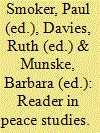

|
|
|
|
|
| Publication |
Oxford, Pergamon Press, 1990.
|
| Description |
xii, 245p.
|
| Standard Number |
0080362869
|
|
|
|
|
|
|
|
|
|
|
|
Copies: C:1/I:0,R:0,Q:0
Circulation
| Accession# | Call# | Current Location | Status | Policy | Location |
| 032694 | 327.172/SMO 032694 | Main | On Shelf | General | |
|
|
|
|
|
|
|
|
|